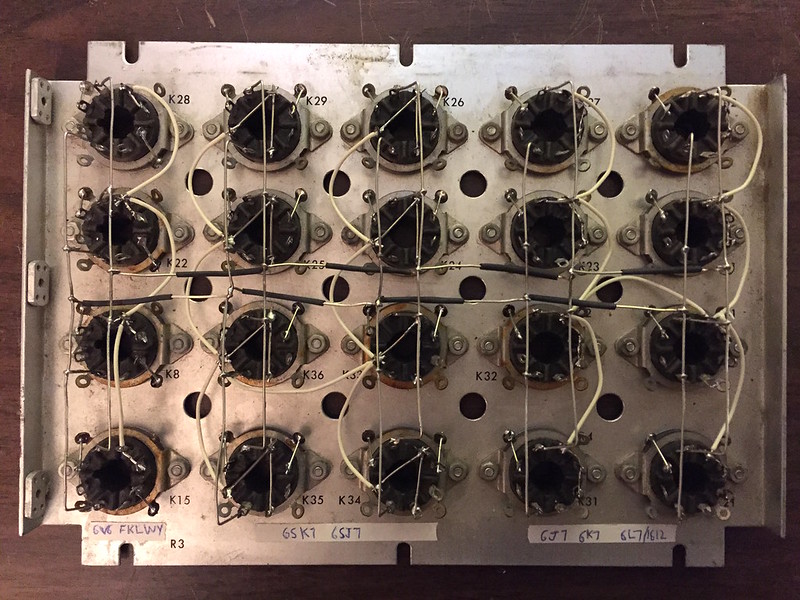Finally put some wires to a plate with 20 octal sockets on it, appears to have housed relays in a previous life. No cathode resistors in yet.
I decided to make room for 3 different basings to cover the following:
6SJ7/6SK7
6J7/6K7/6L7/1612
6F6/6K6/6L6/6V6/6W6/6Y6
On the two small signal types, I'm going with an old RCA Photophone recommendation which I also found quoted in Gates literature from the 1960's, that being 100V B+ to all plates in parallel with individual 2K cathode resistances, grounded grids, triode connection, 100hr burn in before moving on to selection. One very interesting statement was made by RCA Photophone:
The heater voltages are kept constant by means of voltage regulators and are never allowed to fall below 6.3 volts. Experience has shown that a tube in which the heater voltage has fallen below 6.3 volts during aging will not maintain its characteristic and will drift. It is desirable to work these tubes at a plate current somewhat higher than in actual operation to stabilize them.
The power tube section will be used exclusively for tubes going into cathode biased amps. I don't find this subject discussed with specific reference to power types, I imagine the concepts are roughly the same. That basing family covers a lot of territory in terms of usual cathode value and current, I'm thinking 430 or 470 is probably the right range on average for this lot. It'll probably see more use with F/K/Y varieties since they are not typically available with burn-in or pre-matching from any sources. Looking at typical circuits as well, I find everything from G2 lower (more modern) G2 higher (older) and triode connected, so triode connected appears on the surface to be the best way to proceed.
Happy to hear any thoughts or references on the subject. Another assumption for all types with NOS or used tubes is they have been sitting for decades, and a burn-in pass would seem to make sense before matching/testing, even if they already had one in 1955.

I decided to make room for 3 different basings to cover the following:
6SJ7/6SK7
6J7/6K7/6L7/1612
6F6/6K6/6L6/6V6/6W6/6Y6
On the two small signal types, I'm going with an old RCA Photophone recommendation which I also found quoted in Gates literature from the 1960's, that being 100V B+ to all plates in parallel with individual 2K cathode resistances, grounded grids, triode connection, 100hr burn in before moving on to selection. One very interesting statement was made by RCA Photophone:
The heater voltages are kept constant by means of voltage regulators and are never allowed to fall below 6.3 volts. Experience has shown that a tube in which the heater voltage has fallen below 6.3 volts during aging will not maintain its characteristic and will drift. It is desirable to work these tubes at a plate current somewhat higher than in actual operation to stabilize them.
The power tube section will be used exclusively for tubes going into cathode biased amps. I don't find this subject discussed with specific reference to power types, I imagine the concepts are roughly the same. That basing family covers a lot of territory in terms of usual cathode value and current, I'm thinking 430 or 470 is probably the right range on average for this lot. It'll probably see more use with F/K/Y varieties since they are not typically available with burn-in or pre-matching from any sources. Looking at typical circuits as well, I find everything from G2 lower (more modern) G2 higher (older) and triode connected, so triode connected appears on the surface to be the best way to proceed.
Happy to hear any thoughts or references on the subject. Another assumption for all types with NOS or used tubes is they have been sitting for decades, and a burn-in pass would seem to make sense before matching/testing, even if they already had one in 1955.



